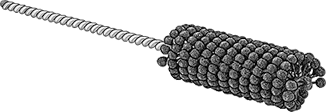I bought 1/2" and 3/4" diameter ball hones from McMaster to hone the ID on a couple of reducing bushings I made for my new Aloris BXA-4 boring bar holder. I know you can buy honing oil but I didn't want a gallon of it.

So what lube do you use for these ball hones? Do you chuck these in the tailstock of the lathe and hone that way or do you drive them with a drill?

So what lube do you use for these ball hones? Do you chuck these in the tailstock of the lathe and hone that way or do you drive them with a drill?



